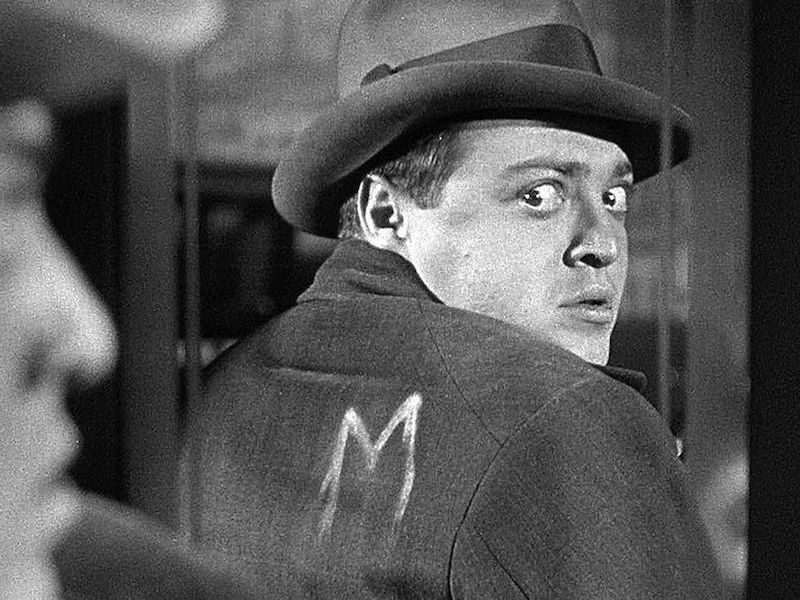Welcome to The Noirvember Files, a new series dropping the spotlight on essential film noir selections. The titles celebrated here exemplify the style and substance of cinema’s grimiest, most-relatable underbelly. In this entry, we explore Fritz Lang’s terrifying, gritty 1931 manhunt thriller, M. Children disappearing off the streets of Berlin, parents forming their own committee for justice? M demands our attention.
The film noir genre explores some pretty dark themes, not least of which is the inevitability of fate. Austrian-German filmmaker Fritz Lang, who is sometimes referred to as the “inventor of film noir,” adopts these themes in M, which follows a city council obsessed with hunting down and punishing a child killer. In the film, Lang explores the deliverance of justice, the horrors of punishment, and how “Judgment Day” will come for all of us in one way or another. Indeed, M is about justice; it is about good and evil, and the helplessness of fate.
Although not overt in the film, one can sense Lang’s anger and disgust with the Germany that was emerging at the time of its release. The streets of Berlin are shadowy and grisly. The faces of those in power are grotesque. In its study of a sadistic murderer named Hans Beckert, (Peter Lorre), on the loose, M takes Lang’s global despair over a dark fate he cannot control and transfers it to a smaller scale. Lang then asks by whom justice should be administered, and which morals can be evaded. From its opening scene, the film explores the scope and dark depths of the justice system and of individual, personal morality.
M begins with a group of children playing “Duck, Duck, Goose.” Lang introduces the film’s themes by placing the camera directly above the kids, appointing the audience as the ultimate voyeur. Whether we like it or not, we are suddenly subjected to a predatory gaze — one which will come back consistently throughout the film. And this inevitably sets the tone for the events to come. Through this God’s-eye view, Lang asks: who has the power to watch? And, perhaps more importantly: who has the power to judge?
The camera then moves to the other side of the balcony and reveals a woman who turns out to be the children’s guardian figure. But the perspective we are initially given is not from the eyes of this woman. It is from the eyes of someone hidden — and is likely just as sinister as that seems. The children’s guardian is busy, nonchalant, and scornful. Someone else is watching our children when we should be.
The scene ends with the guardian leaving the children to their games and walking up the stairs. This foreshadows the ending of M, in which the child-murderer walks in the opposite direction of the protector and descends a staircase into a basement where he is greeted by the ultimate judgment. When the authorities fail to catch Beckert, the townspeople form a committee of their own in order to exact justice for their children. There is one problem, though. The tone of this DIY courtroom is unsettlingly archaic and amateur. The people have one goal: make Beckert suffer. But is that objective not what makes the killer a killer himself?
Instead of looming ominously over the world as it did in the beginning, however, the camera is now leveled with Beckert. He is at the ultimate mercy of the people, and of the film’s viewer. This fact is perhaps most unsettling when Beckert falls to his knees and shouts, “I have to roam the streets endlessly, always sensing that someone’s following me. It’s me! I’m shadowing myself!” Here, it becomes clear that Beckert is tormented by himself just as the townspeople are. Can one really be merciless toward someone who cannot help his own twisted actions?
Beckert’s reference to his “shadow” brings the viewer back to the opening shot of M, in which Lang forces us to become an omniscient shadow, like the killer. Through this, we are unknowingly placed into the shoes and psyche of the film’s killer, or his likes. This poses the question of who should be given the authority to deliver justice.
The film’s second scene transports us to the streets of Berlin, where young Elsie, Beckert’s murder victim, is seen for the first and last time when making her way home from school. Lang then shows us a sign that asks “Who is the Murderer?” Not only is there a murderer on the loose, but this information is accompanied by a question that could mean a multitude of things. Indeed, who is the murderer, but also who is responsible for delivering justice, and who has the right to do so?
The question of who is good and who is bad, and what that means, epitomizes film noir. Good and evil define most of the films in the genre’s sizable catalog, and by constructing a morally ambiguous justice system, M leaves us questioning how we can determine the difference between the two.

